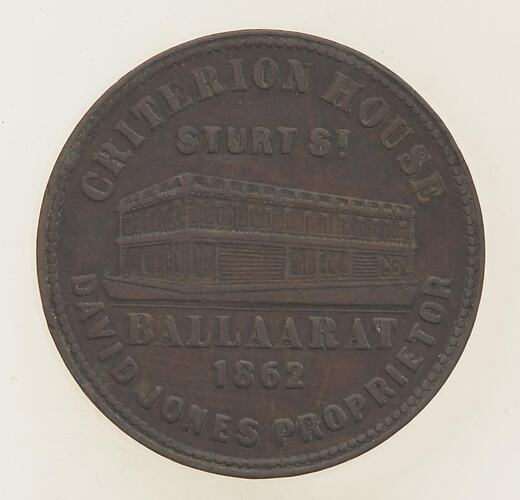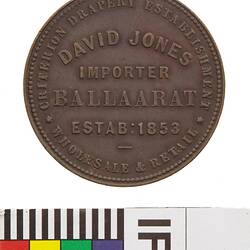David Jones arrived in Victoria about 1850, according to Gardner. His store was, according to his token, 'established 1853.'
His business was originally a partnership, located in Main Street, Ballarat as Hemmingway and Jones, drapers, mercers etc. The partnership was dissolved in the early 1860s. In 1858 their premises were destroyed by fire, along with fifteen other buildings. After the partnership was concluded, Jones built a store at the corner of Armstrong and Sturt Streets that he called Criterion House. He issued tokens bearing that address in 1862 and conducted his business from those premises until he retired in 1871 (Gardner, 1910). His listing in the 1862 Ballarat Directory gives his address as Sturt Street and Main Road, but his 1865 listing says Sturt Street, suggesting that Gardner's dates for his partnership and changes of address are likely to be correct.
His token, issued in 1862, is unusual inasmuch as on the reverse it bears an image of Criterion House, rather than any of the common symbolic figures (Justice, Britannia, Australia) or a coat of arms such as the 'Australian arms', or the Kangaroo and Emu. The tokens are thought to have been manufactured in England.
In 1867 Jones placed a large advertisement on the front page of The Ballarat Courier alerting readers to 'Still further shipments of winter goods' that he had received, including 'Gentlemen's ready-made clothing,' 'The international overcoat' and 'Our assortment of Boots and Shoes, Whether Children's, Ladies' or Gentlemen's, is now as complete as it is possible during the present [indistinct possibly 'scarcity'] for it to be.' The company was described as 'David Jones and Co., London and Ballarat.'
A former member of staff at Criterion House told Gardner that it was 'unquestionably the best drapery business in Australia. He imported the very best goods, employed the best men he could get, did a very fine business, and made very fine profits, which can be imagined when we say that he sold out for £103,000,' (Gardner, 1910). Hope records that he sold out to Christie & Co. of Ballarat (Hope, 2005).
He is said to have been a bachelor and lived above his shop, entertaining celebrities from the stage who visited the city including 'Madame Caradini, Armes Beaumont, (then in his prime), Montgomery and others.' Of his person Gardner says he was 'not a well educated man, but a particularly capable business man, and is described to me by one who met him as the most perfect shop walker he ever met, always most immaculate in dress.'
After retiring he married a widow and returned to England. He travelled the world, returning to Australia on one or two occasions. He died in about 1880. In a note published separately to his biography of Jones, Gardner mentions that according to a correspondent, Jones also kept a store at Magpie, on the road between Ballarat and Buninyong. No dates are given. John Hope's research indicates that Jones had the business at Magpie before he opened his store at Ballarat, i.e. between 1850 and 1853. His apprentice at Magpie was a young man named Robert Reid, who went on to establish 'Robert Reid & Co., Ltd.', a business with branches in Sydney, Melbourne, Brisbane, Adelaide and London.
References:
Gardner, F. (1910). 'Trade Tokens and the Firms who Issued Them', The Australian Storekeepers and Traders Journal, 30 June 1910, p.8.p.17.
Sharples, J. (1993). 'Catalogue of Victorian Trade Tokens', Journal of the Numismatic Association of Australia. Vol. 7, December, p.16.
Advertisement, The Ballarat Courier, 14 June 1867, p.1.
Hope, John (2005). 'David Jones', unpublished MSS, 2pps.
More Information
-
Keywords
-
Localities
-
Authors
-
Article types



